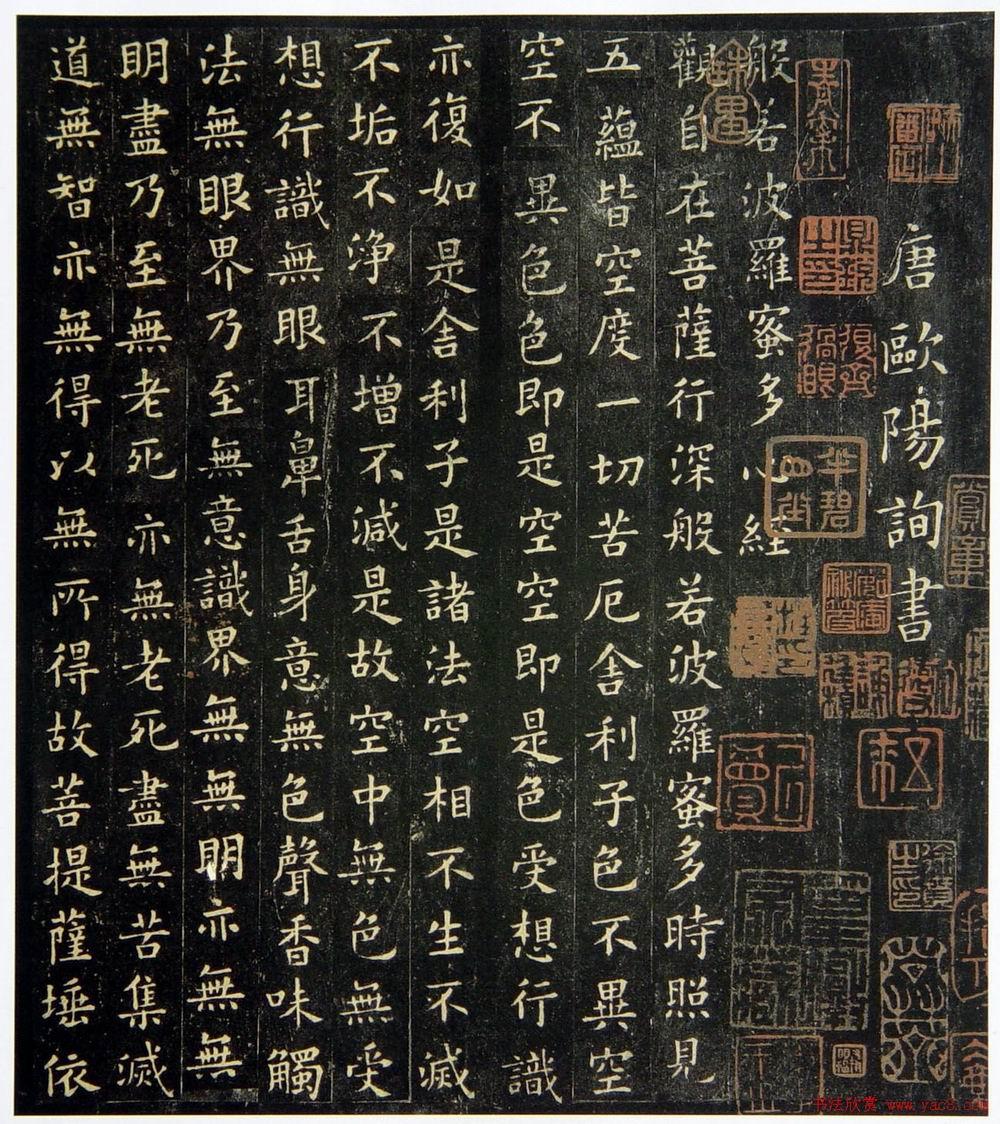
Comparison of characteristics of Yan Oulu and Zhao Kaishu
Ouyang Xun (557-641), Han nationality, was born in Linxiang, Tanzhou (now Changsha, Hunan) in the Tang Dynasty. Liu Ti), one of Zhao Mengfu (Zhao Ti) in the Yuan Dynasty. Born in Hengzhou (now Hengyang, Hunan) in 557 AD, his ancestral home is Linxiang, Tanzhou (now Changsha, Hunan). Ouyang Xun's regular script is unparalleled in the world for its rigor and formidable brushwork, and is known as the number one regular script of the Tang Dynasty. Both he and Yu Shinan were famous for their calligraphy in the early Tang Dynasty, and they were called "Ou Yu".
European Style: The font is based on the "two kings", blending the residual rhyme of Han, Li, Wei and Jin calligraphy, absorbing the strengths of various schools, seeking to find danger in the middle of the square, creating a new idea, and becoming a school of its own. In terms of brush and stippling, the square brush is basically the main one, and the round brush is used occasionally. The writing is easy and natural, clean and neat, the strokes are slow and reserved, there is no pause, and the finishing is meticulous. Dot painting pays attention to echoing and coherence, and the strokes pursue changes. The dots are like triangles. Square pens are often used for horizontal and vertical pens, and round pens are often used for writing. The brushstrokes are flexible and vivid. The method of hook painting is based on Li, with full posture, vigorous momentum, and most of the turning points are square with round momentum, showing both square strength and vigorousness. In terms of structure, it should be slender, with four sides even and firm, tight on the sides, more prominent peaks, tight on the left, stretched on the right, vertical as the main body, horizontal as a pattern, and strict laws and regulations. The center is well-distributed and dense (the middle palace is tighter), and most of them expand to the right, while the center of the characters is generally slightly to the left, dangerous and ingenious, calm and rigorous, and impeccable.

European (Yang Xun) style
Yan Zhenqing (709-784, some say 709-785), courtesy name Qingchen, was a statesman and an outstanding calligrapher in the mid-Tang Dynasty. He was born in Linyi, Langya, and was the grandson of the fifth generation of Yan Shigu. In the 22nd year of Kaiyuan (734 A.D.), Jinshi, Deng Jiake, was appointed as the supervisory censor four times, and moved to the palace to serve as the censor. Rejected by Yang Guozhong, the power minister at the time, he was demoted to serve as the prefect of Pingyuan County, known as "Yan Pingyuan". During Suzong's time, he went to Fengxiang to teach the Minister of the Ministry of Constitution and moved to the doctor of imperial history. During Daizong's reign, he was appointed Minister of the Ministry of Officials, Prince Taishi, Duke of Lu County, known as "Yan Lugong". In the first year of Xingyuan (784), he was framed by the prime minister Lu Qi, and was sent to the rebel general Li Xilie's department to tell him that he refused the thief sternly, and was finally hanged. Yan Zhenqing founded the "Yan Style" regular script, and together with Zhao Mengfu, Liu Gongquan, and Ouyang Xun, he was called the "Four Masters of Regular Script".
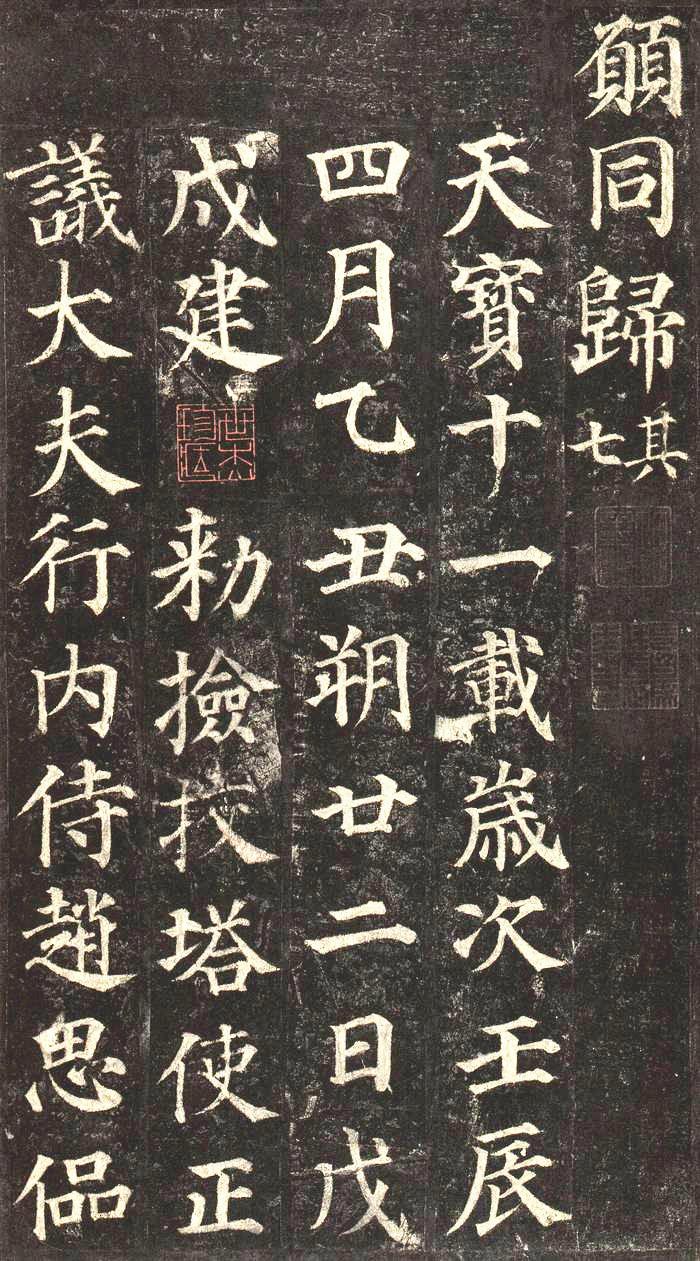
Color body
Yan style: widely absorbing the techniques of calligraphers of the Six Dynasties, Sui and Tang Dynasties, integrating all kinds of things into one furnace, following the predecessors but being stupid and innovative, creating a new style, with strong and thick strokes, smooth and dense frames, majestic and changeable, dense at the top and sparse at the bottom, It is as towering as Mount Tai. The strokes of the pen are vigorous, the pen starts with a hidden front and turns round, the pen is centered, and the ink is light and heavy vertically. The Nai pen has the state of "silkworm head and swallow tail". The turning point mostly presents an inner square and an outer circle. The strokes of the hook pen are mostly in the shape of a bird's beak, the structure of the characters is broad, square and full, the left and right are basically symmetrical, dignified and stable, showing a graceful, open and magnificent spirit. Yan Kai especially strengthened the role of using the wrist in brushwork, and made more use of the Tibetan front to form the characteristics of solidity, plumpness and strength. The strokes of Yan Ti are generally symmetrical, but the vertical strokes tend to be inwardly and environmentally friendly, with a slightly curved shape. The shape of the official script is full of meaning, which means that the whole character has a round and deep appearance, with a strong inner meaning, and has a profound artistic effect.
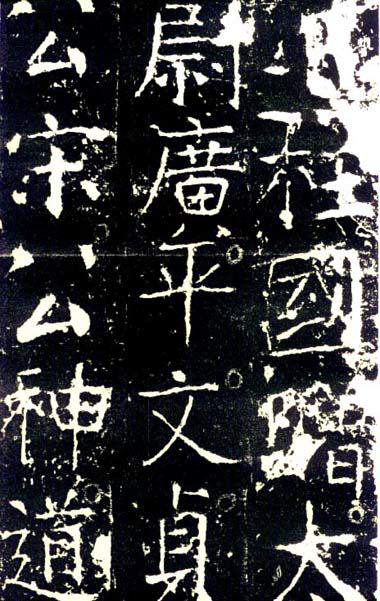
Yan (Zhenqing) Style, "Song Jing Monument"
"Song Jing Stele", made in 773 AD, was originally located in Shahe County, Hebei Province, and was unearthed in the middle of Ming Dynasty. Scholars believe that the brushwork and meaning of the "Hua Crane Ming" conveys a simple and elegant style, and a graceful and elegant spirit. Huang Tingjian said: "It is magnificent and beautiful, and it has the spirit of the Wei, Jin, Sui and Tang Dynasties."
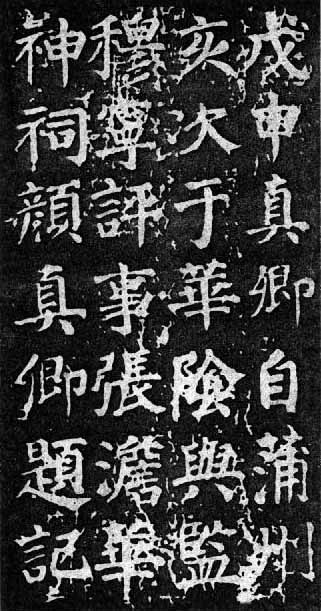
"Title of Jintianwang Temple"
"Inscription of Jin Tianwang Temple" (written in 758), this is the title of Yan Zhenqing's visit to Huayue Temple when he was demoted from Puzhou governor to Raozhou governor, in regular script. The handwriting is magnificent and strong, the brushwork is round and vigorous, from square to round, hard crossbow ready to stretch, majestic and upright, bold and inviolable.
Liu Gongquan (AD 778-AD 865), with the character Chengxuan, was a calligrapher in the Tang Dynasty and one of the four masters of regular script. Han nationality, from Jingzhaohuayuan (now Yaozhou District, Tongchuan City, Shaanxi Province). From the official to the prince's Shaoshi, he is known as "Liu Shaoshi" in the world. Liu Gongquan's calligraphy is famous for its regular script, which is as famous as Yan Zhenqing, and is known as Yan Liu. He learned calligraphy from Wang Xizhi for the first time, and after looking at the calligraphy of famous masters in the Tang Dynasty, he thought that Yan Zhenqing and Ouyang Xun's calligraphy were the best, so he absorbed the strengths of Yan and Ou, and formed his own style between the Jin people's charm and Yan Shu's grace and majesty. Willow body is known for its strong and strong bones, and later generations have the reputation of "Yan Jin Liu Gu".

Liu Gongquan's early regular script work "Teaching His Disciples"
Liu Ti: famous calligraphy in the late Tang Dynasty. Learn the "two kings" for the first time, then learn the brushwork of various schools in the Sui and Tang Dynasties, and then further change the use of color and style, and find a new way to innovate and create a school of its own. The book style is rigorous in structure, sparse and open, with a square layout, strong and straight, strong in bones, and handsome in spirit, so it has become a model for future generations. Its stippling is strong, strong and flexible, and the horizontal and vertical strokes are extended to all sides. The general situation is open. fill. Horizontal paintings are mostly collected from the square, and vertical paintings are mostly used to start against the peak. After stopping the pen, lead the peak to go down. Naiduo has a certain arc. Although he is tall and straight, he has internal bone strength. Use the pen to carry out the press and press it vigorously. Based on the face style, the characters are compact and bold, the central palace is tightened, and the four sides are open, tight but not restricted, sparse but not scattered, full of changes in the regularity, and occasionally dangerous and strange in the regular.
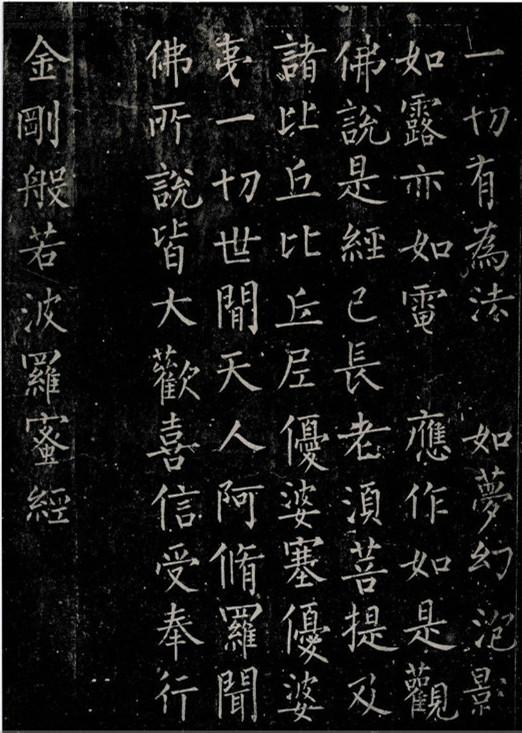
The Diamond Sutra

The Diamond Sutra
"Diamond Sutra" was engraved in April of the fourth year of Tang Changqing (824). It was written by Liu Gongquan when he was 47 years old. The full name is "Diamond Prajna Paramita Sutra". The original stone was lost long ago. In 1908, an isolated copy of Tang Tuo was discovered in the Dunhuang Grottoes. It is undamaged and extremely rare. It is now in the Paris Museum of France. Shanghai Youzheng Bookstore, Wenming Bookstore, Zhonghua Bookstore, and Cultural Relics Publishing House all have photocopies in the world.
Zhao Mengfu (1254-1322), courtesy name Ziang, nicknamed Songxue, Taoist Songxue, also known as Shuijingong Taoist, Oubo, was Meng Fu in his middle age. Han nationality, the 11th grandson of Song Taizu Zhao Kuangyin and the direct descendant of Qin Wang Zhao Defang. Wu Xing (now Huzhou, Zhejiang) people. Famous poet and painter in the Yuan Dynasty, one of the four masters of regular script (Ouyang Xun, Yan Zhenqing, Liu Gongquan, Zhao Mengfu). Zhao Mengfu is erudite and versatile, good at poetry and prose, economics, calligraphy, fine painting, good at gold and stone, proficient in rhythm and appreciation. In particular, calligraphy and painting achieved the highest achievement, and created a new style of painting in the Yuan Dynasty, known as "the crown of the Yuan people". He is also good at seal script, official script, true script, running script and cursive script, and is especially famous for regular script and running script.
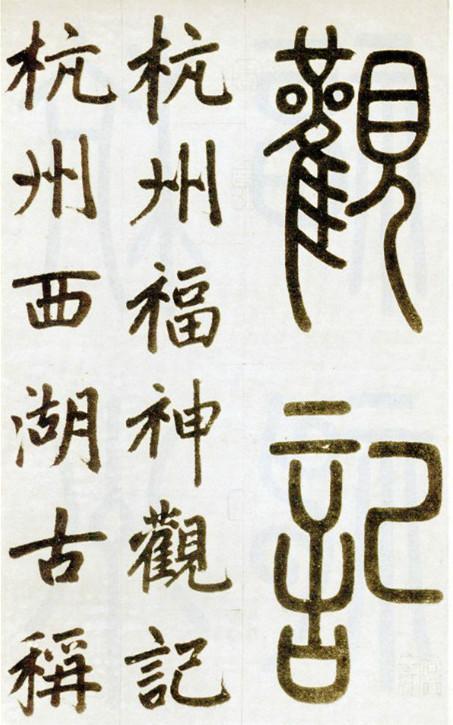
Zhao Mengfu's "Hangzhou Fushen Temple"
Zhao Mengfu's "Hangzhou Fushen Guanji"
Originally written by Deng Wen, regular script by Zhao Mengfu. Paper version, black silk square. The full name is "Hangzhou Fushen Guanji", which was written by Zhao Mengfu when he was sixty-seven years old in the seventh year of Yuan Yanyou (AD 1320). Its calligraphy structure is wide, broad, deep and stable, smooth and round, round and vigorous, similar to "Danba Stele" and "Chou E Epitaph". It is older than other inscriptions and is one of Zhao Shu's masterpieces. . The monument is on the left of the Broken Bridge in West Lake, Hangzhou.
Zhao Ti: The artistic achievement of regular script is the highest. The regular script is done, and the pen is used by the center, which is smooth and smooth. The structure is well-proportioned, so that it is charming and plump, graceful and graceful, and its beauty is obviously different from the styles of Ou, Yan, and Liuzi. Its representative work is "Banba Tablet". Zhao characters are characterized by various postures, round and vivid, echoing looking and looking, but actually coherent, drawing horizontally and vertically, walking with the pen slightly raised in the middle, retracting the pen back to the front, and the whole movement of the pen is calm and decisive, generally upward to the right. Most of the vertical paintings are vertical, often with a slight left arc according to the needs of the structure, and the arc surrounds the center of the character. The folding method is at the intersection of horizontal and vertical. After a short pause, the stroke will be straightened down. This is different from Yan Liu's writing method of starting from scratch and gaining momentum. Bo Nai's brush strokes are fast, and his strokes are sharp, most of which are not exposed. The structure is well-proportioned and comfortable, the strokes are dense and dense, and the side parts are coordinated and blended. However, it should be emphasized that the Zhao style characters are smooth and round, but the strokes are relatively fast. When writing, the writing should not be frivolous, weak, and sharp.

Zhao Mengfu's regular script "Xiaoshan County School Reconstruction of Dacheng Palace" in Yuan Dynasty
Which of the four fonts Yan Liu Ou Zhao is easier to use?
Zhao body is relatively neat and stable, with clear strokes.
The willow body is square and round, and the font is thin and hard
The European style is suitable for beginners, the structure is elegant and generous, it seems to be flat, but it is actually steep
The face, body and pen are strong and round.

Articles are uploaded by users and are for non-commercial browsing only. Posted by: Lomu, please indicate the source: https://www.daogebangong.com/en/articles/detail/A%20Comparison%20of%20the%20Characteristics%20of%20the%20Regular%20Scripts%20of%20the%20Four%20Masters%20of%20Chinese%20Calligraphy.html

 支付宝扫一扫
支付宝扫一扫 
评论列表(196条)
测试